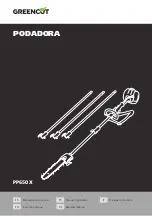
7
ENGLISH
METALCUTTING (fig.7)
• Use a finer blade for ferrous metals and a coarse blade
for non-ferrous materials.
• In thin gauge sheet metals it is best to clamp wood to
the underside of the sheet. This will ensure a clean cut
without excess vibration or tearing of metal.
• Avoid forcing cutting blade as this reduces blade life
and causes costly blade breakage.
NOTE:
Spread a thin film of oil or other coolant along the
line ahead of the saw cut for easier operation and longer
blade life.
POCKET CUTTING-WOODONLY (fig.8)
• Measure the surface area to be cut and mark clearly
with a pencil, chalk or scriber.
• Insert blade in blade clamp and tighten blade clamp
securely.
• Tip the saw backward until the back edge of the shoe is
resting on the work surface and the fully extended
moving blade will clear the surface.
• Grip unit with both hands, switch motor on permitting
blade to obtain maximum speed.
• Begin a slow, deliberate upward swing with the main
handle of the saw.
• The blade will begin to feed into material. Always be
sure blade is completely through material before
continuing with pocket cut.
NOTE:
In areas where blade visibility is limited, use the
edge of the shoe as a guide.
PROJECT TIPS
• Cut only with sharp blades; they cut cleaner, faster and
put less strain on the motor while cutting.
• When cutting, always ensure that the shoe is held
firmly against the workpiece and the workpiece is
secured from moving/deflecting. This will improve
operator control and minimize vibration.
• For longer blade life, use bi-metal blades. These utilize
a carbon steel back welded to high speed steel teeth
making the blade more flexible and less prone to
breaking.
ACCESSORIES
This saw will accept up to a 12 inch long blade. Always use
the shortest blade suitable for your project but long enough
to keep the blade cutting through the material. Longer
blades are more likely to be bent or damaged during use.
During operation some longer blades may vibrate or shake
if the saw is not kept in contact with the workpiece.
WARNING:
Since accessories, other than those offered
by Stanley, have not been tested with this product, use of
such accessories with this tool could be hazardous. To
reduce the risk of injury, only Stanley recommended
accessories should be used with this product.
Maintenance
Your Stanley tool has been designed to operate over a long
period of time with a minimum of maintenance. Continuous
satisfactory operation depends upon proper tool care and
regular cleaning.
Warning!
Before performing any maintenance, switch off
and unplug the tool.
• Regularly clean the ventilation slots in your tool using a
soft dry brush or dry cloth.
• Regularly clean the motor housing using a clean damp
cloth. Do not use any abrasive or solvent-based
cleaner.
Service Information
Stanley offers a full network of company-owned and
authorized service locations throughout Asia. All Stanley
Service Centers are staffed with trained personnel to
provide customers with efficient and reliable power tool
service.Whether you need technical advice, repair, or
genuine factory replacement parts, contact the Stanley
location nearest to you.
Notes
• Stanley's policy is one of continuous improvement to
our products and, as such, we reserve the right
tochange product specifications without prior notice.
• Standard equipment and accessories may vary by
country.
• Product specifications may differ by country.
• Complete product range may not be available in all
countries. Contact your local Stanley dealers for range
availability.
Summary of Contents for STEL365
Page 1: ...STPT0900 STEL365 3 English Original Indonesia 8 12 Ti ng Vi t 16...
Page 2: ...3 4 A E D C B F 2 5 1...
Page 3: ...4 7 6 8...
Page 12: ...12 Stanley 1 2 STEL365 STPT0900 W 900 V 220 240 0 3200 3 2 RCD RCD 3 4 STEL365 STPT0900...
Page 13: ...13 5 Stanley V A Hz W min n0 II mnt bpm 1 A B C D E F...
Page 14: ...14 2 3 4 1 2 4 3 4 1 2 5 M4 5 32in 5 6 7...
Page 15: ...15 8 12 Stanley Stanley Stanley Stanley Stanley Stanley Stanley Stanley...






































